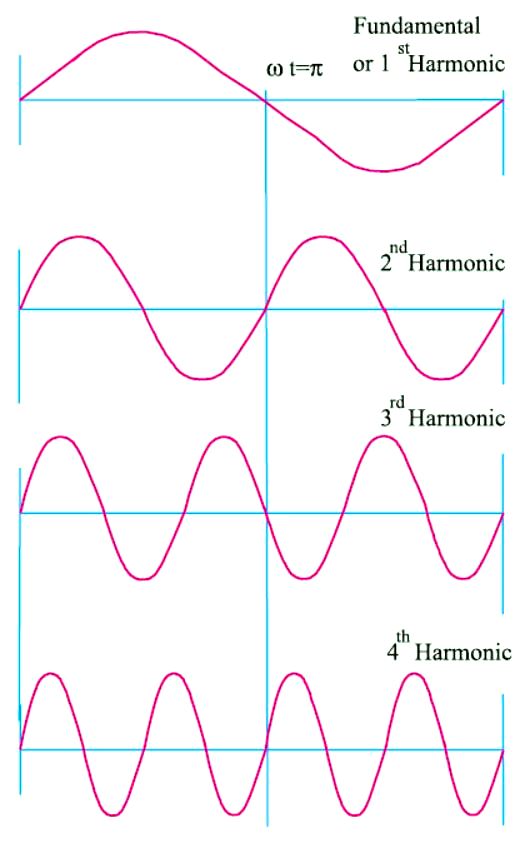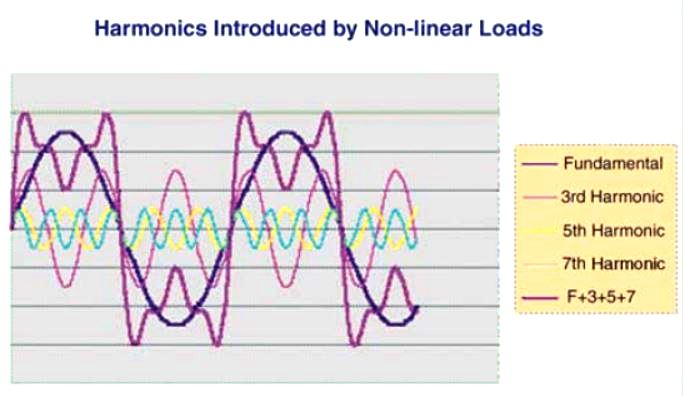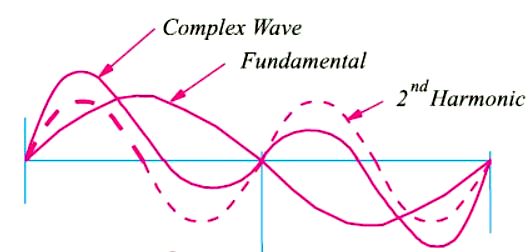Fundamental Wave and Harmonics
Fundamental Wave and Harmonics
While dealing with alternating voltages and currents, it has been assumed that they have sinusoidal waveform or shape. Such a waveform (Fundamental Wave and Harmonics) is an ideal one and much sought after by the manufacturers and designers of alternators. But it is nearly impossible to realize such a waveform in practice. All the alternating waveforms deviate, to a greater or lesser degree, from this ideal sinusoidal shape. Such waveforms are referred to as non-sinusoidal or distorted or complex waveforms.

Complex waveforms are produced due to the superposition of sinusoidal waves of different frequencies. Such waves occur in speech, music, TV, rectifier outputs and many other applications of electronics. On analysis, it is found that a complex wave essentially consists of
(a) a fundamental wave – it has the lowest frequency, say ‘f’
(b) a number of other sinusoidal waves whose frequencies are an integral multiple of the fundamental or basic frequency like 2f, 3f and 4f etc.
The fundamental and its higher multiples form a harmonic series. As shown in Figure (A), fundamental wave itself is called the first harmonic. The second harmonic has frequency twice that of the fundamental, the third harmonic has frequency thrice that of the fundamental and so on.
Waves having frequencies of 2f, 4f and 6f etc. are called even harmonics and those having frequencies of 3f, 5f and 7f etc. are called odd harmonics. Expressing the above is angular frequencies, we may say that successive odd harmonics have frequencies of 3ω, 5ω and 7ω etc. and even harmonics have frequencies of 2ω, 4ω and 6ω etc.

As mentioned earlier, harmonics are introduced in the output voltage of an alternator due to many reason such as the irregularities of the flux distribution in it. Considerations of waveform and form factor are very important in the transmission of a. c. power but they are of much greater importance in radio work where the intelligibility of a signal is critically dependent on the faithful transmission of the harmonic structure of sound waves.
In fact, it is only the rich harmonic content of the consonants and lesser at still plentiful harmonic content of vowels which helps the ear to distinguish a well regulated speech from a more rhythmical succession of musical sounds.
AdBlock-2

Different Complex Waveforms
Let us now find out graphically what the resultant shape of a complex wave is when we combine the fundamental with one of its harmonics. Two cases would be considered (i) when the fundamental and harmonic are in phase with each other and have equal or unequal amplitudes and (ii) when there is some phase difference between the two.
In Figure (D), the fundamental and second harmonic, both having the same amplitude, have been shown by the firm and broken line respectively. The resultant complex waveform is plotted out by algebraically adding the individual ordinates and is shown by thick line. It may be noted that since the maximum amplitude of the harmonic is equal to the maximum amplitude of the fundamental, the complex wave is said to contain 100% of second harmonic.

General Equation of a Complex Wave
Consider a complex wave which is built up of the fundamental and a few harmonics, each of which has its own peak value of phase angle. The fundamental may be represented by
e1 = E1m sin (ωt+Ψ1)
the second harmonic bye e2 = E2m sin (2ωt+Ψ2)
the third harmonic by e3 = E3m sin (3ωt+Ψ3)
The equation for the instantaneous value of the complex wave is given by
e = e1 + e2 + …. en
= E1m sin (ωt+Ψ1) + E2m sin (2ωt+Ψ2) + ……. + Enm sin (nωt+Ψn)
when E1m, E2m and Enm etc. denote the maximum values or the amplitudes of the fundamental, second harmonic and nth harmonic etc. and Ψ1 Ψ2 and Ψn represent the phase differences with respect to the complex wave* (i.e. angle between the zero value of complex wave and the corresponding zero value of the harmonic).
The number of terms in the series depends on the shape of the complex wave. In relatively simple waves, the number of terms in the series would be less, in others, more. Similarly, the instantaneous value of the complex wave is given by
i = I1m sin (ωt+Ψ1) + I2m sin (2ωt+Ψ2) + ……. + Inm sin (nωt+Ψn)
Obviously (Ψ1− φ1) is the phase difference between the harmonic voltage and current for the fundamental, (Ψ2− φ2) for the second harmonic and (Ψn− φn) for the nth harmonic.
Read article – Units of Resistivity
Visit NCERTplanet.com for NCERT solutions and Textbook downloads



